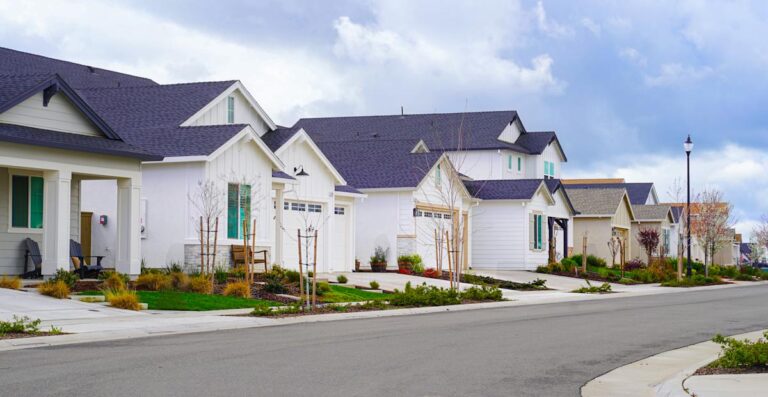The US is in the middle of the typical peak homebuying season, but all signs suggest that the market remains sluggish.
Housing contract activity slipped sharply in April, even though buyers had more inventory to choose from. Meanwhile, buyers and sellers are locked in something of a standoff: More sellers are listing their properties, but prices haven’t fallen much, and buyers are being picky.
Shop Top Mortgage Rates
Powered by Money.com – Yahoo may earn commission from the links above.
Mortgage rates aren’t helping. They’ve held remarkably stable this year, hovering between 6.8% and 7%. Rate stability can be a good thing because buyers know what to expect when financing. But stability at relatively high levels prices many potential buyers out of the market altogether. Many would-be buyers find they’re able to rent a much larger home than they could afford to buy.
“There was a little bit of a failure to launch feeling” this spring, said Hannah Jones, senior economic research analyst at Realtor.com. “High home prices persisted. High mortgage rates persisted. Economic uncertainty picked up. All of that we see reflected in the housing data.”
What it will take to bring life back to the market isn’t clear. Lower rates would certainly help, but there’s little reason to think they’ll return to 3% or 4% anytime soon, barring a deep recession. Recessions come with their own housing market tradeoffs, like higher unemployment that reduces demand and elevated mortgage delinquencies.
Yahoo Finance compiled charts that illustrate how quickly the housing market shifted in the last five years, and why it’s at a standstill now.
Home price growth has outpaced wage inflation
For decades, home price appreciation has been outstripping earnings growth. In the last 25 years, home values have more than tripled. The steepest climb came between 2020 and 2022, when pandemic moves and ultra-low mortgage rates spurred a buying frenzy across the country.
Meanwhile, median incomes from 2000 to 2023 did not quite double.
People with 3% mortgages are hanging onto them
In recent years, the housing market has been stalled by what’s known as the rate “lock-in effect.” Anyone lucky enough to have a sub-4% mortgage rate at a time when prevailing mortgage rates are closer to 7% is reluctant to give up that cheap rate in a move. That effect has kept for-sale inventory depressed.
As the days of 3% and 4% mortgages become more distant, the hope is that the lock-in effect will ease. Those who bought after mid-2022 usually have higher rates they’re less wedded to hanging onto. And some people with ultra-low mortgage rates find themselves needing to move anyway, perhaps for a new job or if they’re expecting a baby. But as of the end of 2024, more than half of homeowners are still hanging on to rates below 4%.
“By and large, sellers are still feeling that pressure of their low mortgage rate,” Jones said.
Supply is up, but list prices aren’t falling
For-sale inventory has been rapidly increasing in recent years, giving prospective buyers more homes to choose from. While inventory hasn’t quite returned to pre-pandemic levels nationwide, it exceeds that in certain regions, especially states in the South and the West. There, home price appreciation is slowing, and in some cases prices are falling outright.
But in many parts of the country, prices are still rising. Median list prices remain near all-time highs. Coupled with higher mortgage rates, that leaves many buyers priced out.
Some economists expect home prices to fall on a national level this year by 1% to 2%, a small help in an environment where prices are up about 38% from pre-pandemic levels.
High mortgage rates have dramatically reduced buying power
“It is all about mortgage rates,” National Association of Realtors Chief Economist Lawrence Yun said after home contract activity had its worst April since 2009. “Lower mortgage rates are essential to bring homebuyers back into the housing market.”
A family making the median US income of around $80,000 could comfortably afford to spend around $2,400 a month on housing, using conventional affordability guidelines. If they put 15% down on their home purchase — roughly the average-sized down payment — they could afford to buy a home costing up to $543,000 with a 3% mortgage rate.
But if their mortgage rate is 7%, their buying power goes down to $356,000. That’s less than where the median home is listed today. At current mortgage rates, the median earner can’t afford to buy the median home.
Buying has rarely been so much more expensive than renting
What’s a priced-out buyer to do? In many cases, the answer is to rent. Buying a home has historically cost more than renting one, after factoring in maintenance, insurance, and other so-called “hidden costs” of ownership. But the premium for ownership began rising rapidly alongside prices and mortgage rates in the aftermath of the pandemic.
Historically, buying a starter home cost an average of $233 more per month than renting a comparable unit. In late 2024, that premium was over $1,000 a month, according to John Burns Research & Consulting. For homeownership costs to return to the historical average premium, mortgage rates would need to fall to 3.75%.
In comments on Wednesday, Federal Reserve Chairman Jay Powell acknowledged the market’s challenges.
“We have a longer-run shortage of housing, and we also have high rates right now,” Powell said. “I think the best thing we can do for the housing market is to restore price stability in a sustainable way and create a strong labor market.”
Claire Boston is a Senior Reporter for Yahoo Finance covering housing, mortgages, and home insurance.
